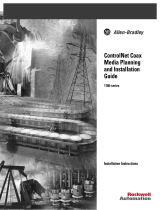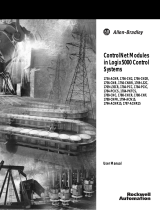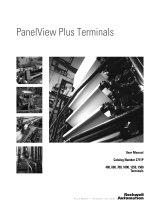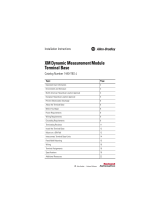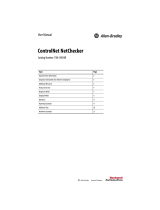Page is loading ...

1786-5.7 - February 1999
Installation Instructions
ControlNet Coax Tap
(Cat. Nos. 1786-TPR, -TPS, -TPYR, -TPYS)
What’s in This Document
Use this document as a guide when installing a ControlNet™ coax tap.
Verify Your Package Contents
Make sure you have these items before you discard any packing material.
To: See Page:
verify package contents 1
select where to mount the tap 4
mount the tap 4
For reference on: See Page:
mounting dimensions 7
specifications 6
Important:For information on planning and installing your ControlNet
cable system, see the ControlNet Cable System Planning and
Installation Manual, publication 1786–6.2.1.
universal mounting bracket
BNC connector kits
screws
tap (1786-TPR, -TPS,
-TPYR or -TPYS)
dust cap
If an item is missing or incorrect, contact your Allen-Bradley distributor or sales office.
41644
AB Parts

1786-5.7 - February 1999
2 ControlNet Coax Tap
CSA Statement
When the product is marked with the CSA Hazardous Location marking, it
is suitable for use in Class I, Division 2 Hazardous Locations and
nonhazardous locations only when installed with products bearing the
Allen-Bradley ControlNet name or logo, and like certifications.
CSA logo is a registered trademark of the Canadian Standards Association.
CSA Hazardous Location Approval
CSA certifies products for general use as well as for use in hazardous locations. Actual CSA certification is indicated by the
product label as shown below, and not by statements in any user documentation.
Example of the CSA certification product label:
To comply with CSA certification for use in hazardous locations, the following information becomes a part of the product literature for
this CSA-certified industrial control product.
• This equipment is suitable for use in Class I, Division 2, Groups A, B, C, D, or non-hazardous locations only.
• The products having the appropriate CSA markings (that is, Class I, Division 2, Groups A, B, C, D) are certified for use in other
equipment where the suitability of combination (that is, application or use) is determined by the CSA or the local inspection office
having jurisdiction.
Important: Due to the modular nature of a programmable control system, the product with the highest temperature rating determines
the overall temperature code rating of a programmable control system in a Class I, Division 2, location. The temperature code rating is
marked on the product label as shown.
Temperature code rating:
The following warnings apply to products having CSA certification for use in hazardous locations.
ATTENTION: Explosion hazard -
• Substitution of components may impair suitability for Class I, Division 2.
• Do not replace components unless power has been switched off or the area is known to be non-hazardous.
• Do not disconnect equipment unless power has been switched off or the area is known to be non-hazardous.
• Do not disconnect connectors unless power has been switched off or the area is known to be non-hazardous.
Secure any user-supplied connectors that mate to external circuits on this equipment by using screws, sliding
latches, threaded connectors, or other means such that any connection can withstand a 15 Newton (3.4 lb.)
separating force applied for a minimum of one minute.
CL I, DIV 2
GP A,B,C,D
TEMP
CL I, DIV 2
GP A,B,C,D
TEMP
!

1786-5.7 - February 1999
ControlNet Coax Tap 3
Complément d’information
Si ce produit porte le marquage CSA, il convient à une utilisation en
environnements dangereux de Classe 1, Division 2 et non dangereux
uniquement s’il est installé avec des produits portant le nom ou le logo
ControlNet d’Allen-Bradley ou des certifications similaires.
Le sigle CSA est la marque déposée de l'Association des Standards pour le Canada.
Approbation d’utilisation en environnements dangereux par la CSA
La CSA certifie des produits pour une utilisation générale aussi bien que pour une utilisation en environnements dangereux. La
certification CSA en vigueur est indiquée par l'étiquette produit et non par des indications dans la documentation utilisateur.
Exemple d'étiquette de certification d'un produit par la CSA :
Pour satisfaire à la certification CSA en environnements dangereux, les informations suivantes font partie intégrante de la
documentation des produits industriel de commande industrielle certifiés.
• Cet équipement ne convient qu’à une utilisation en environnements de Classe 1, Division 2, Groupes A, B, C, D, ou non dangereux.
• Les produits portant le marquage CSA approprié (c'est à dire, Classe 1, Division 2, Groupes A, B, C, D) sont certifiés pour une
utilisation avec d'autres équipements, les combinaisons d’applications ou d’utilisations étant déterminées par la CSA ou le bureau
local d'inspection qualifié.
Important : De par la nature modulaire des systèmes de commande programmables, le produit ayant le code de température le plus
élevé détermine le code de température global du système dans un environnement de Classe 1, Division 2. Le code de température
est indiqué sur l'étiquette produit.
Code de température
:
Les avertissements suivants s'appliquent aux produits ayant la certification CSA pour une utilisation en environnements dangereux.
DANGER : Risque d’explosion
• La substitution de composants peut rendre cet équipement inadapté à une utilisation en environnements de
Classe 1, Division 2.
• Couper le courant ou s’assurer que l’environnement est classé non dangereux avant de remplacer des
composants.
• Couper le courant ou s’assurer que l’environnement est classé non dangereux avant de débrancher l’équipement.
• Couper le courant ou s’assurer que l’environnement est classé non dangereux avant de débrancher les
connecteurs. Fixer tous les connecteurs fournis par l’utilisateur pour se brancher aux circuits externes de cet
équipement à l ‘aide de vis, loquets coulissants, connecteurs filetés ou autres, de sorte que les connexions
résistent à une force de séparation de 15 newtons (1,5 kg - 3,4 lb) appliquée pendant au moins une minute.
CL I, DIV 2
GP A,B,C,D
TEMP
CL I, DIV 2
GP A,B,C,D
TEMP
Le code de température
est indiqué ici
!
AB Parts

1786-5.7 - February 1999
4 ControlNet Coax Tap
Select Where to Mount Your Tap
Use these guidelines to select where to mount your taps.
• There is no spacing requirement between taps; you can install two
adjacent taps using a barrel connector (1786-BNC).
• Make sure the mounting location is convenient for your cable routing.
• Make sure the mounting location allows your wiring to meet these
requirements:
– In conduit - installation of RG6 Quad Shield type coax cable
conforms to this pull force and bend radius:
– Not in conduit - installation of RG6 Quad Shield type coax cable
conforms to this bend radius:
• Do not mount the tap in a position that routes the dropline cable over any
ac power terminals on nearby modules.
Mount Your Taps
You can mount your ControlNet tap (T-tap or Y-tap):
• to a universal mounting bracket, and then mount the tap and bracket as
an assembly
• through the body holes in the tap using:
– screws and flat washers
– and a tie wrap.
Once you have mounted your taps, you can store or discard any unused
universal mounting brackets.
See page 7 for universal mounting bracket and tap mounting dimensions.
For this coax
cable:
The pull strength
should not exceed:
The bend radius
should exceed:
PVC 42.75kg (95lbs) 76.2mm (3.0 in)
FEP 61.65kg (137lbs) 69.9mm (2.75 in)
For this coax cable: The bend radius
should exceed:
PVC 38.1mm (1.5”)
FEP 35.6mm (1.4”)
Tap drop cable 25.4mm (1.0”)
!
ATTENTION: Do not allow any metal portions of the tap,
such as the universal mounting bracket screws or connectors to
contact any conductive material. This contact could cause noise
on the network.

1786-5.7 - February 1999
ControlNet Coax Tap 5
Mounting a Tap Using a
Universal Mounting Bracket
1. Align the universal mounting bracket with the mounting holes on the tap.
2. Using screws provided with the tap, attach the tap to the universal
mounting bracket.
3. Mount the tap and bracket assembly to:
Use only the screws that are packaged with the tap. They are the proper length and head style.
universal mounting bracket
(provided with tap)
Y-tap
dust cap
universal mounting
bracket
T-tap
dust cap
20080-M20084-M
!
ATTENTION: Do not over tighten the screws. Over
tightening the screws can damage the tap. The applied torque
should be 0.2-0.4 N-m (1-2 ft.-lbs).
Mount the universal bracket on specified Allen-Bradley mounting rails or DIN rails #3 style symmetrical (35 X 7.5mm)
universal mounting bracket
DIN rail
suitable fixture
universal mounting bracket
Type of rail Cat. No. Type of rail Cat. No.
A-B rail 1492-N1 Din Rail #3 199-DR1
1492-N22 1492-DR5
1492-N44 1492-DR6
1492-DR7
Use four screws to attach the
universal mounting bracket to
another surface
a DIN Mounting Rail
or
another mounting surface
20082-M
20081-M
AB Parts

1786-5.7 - February 1999
6 ControlNet Coax Tap
Mounting a Tap Through Body Holes
Mount the tap to a suitable fixture using:
Important:The suitable fixture can be conductive and/or grounded because
of the electrical isolation provided by these body holes.
Specifications
The following table lists the specifications for the ControlNet taps.
body holes
body holes
tie wrap
screws and flat washers
You can use a variety of screw types.
a tie wrap
or screws and flat washers
(not supplied)
41645
41646
!
ATTENTION: Do not over tighten the screws. Over
tightening the screws can damage the tap. The applied torque
should be 0.2-0.4 N-m (1-2 ft.-lbs). Do not use screws larger
than #8 in these holes.
Operating temperature -0 to 60°C (32 to 140°F)
Storage temperature -40 to 85°C (-40 to 185°F)
Relative humidity 5 to 95% noncondensing

1786-5.7 - February 1999
ControlNet Coax Tap 7
Mounting Dimensions
Use these mounting dimensions to mount your taps and universal mounting
brackets.
Universal Mounting Bracket
Taps
49.53 mm
(1.95 in
19.05mm
(0.75 in)
15.47 mm
(0.609 in)
9.53 mm
(0.375 in)
30.94 mm
(1.218 in)
20170-M
58.42 mm
(2.30 in)
25.4 mm
(1.00 in)
35.56 mm
(1.40 in)
15.24 mm
(0.60 in)
33.02 mm
(1.30 in)
39.37 mm
(1.55 in)
31.37 mm
(1.235 in)
15.24 mm
(0.60 in)
30.23 mm
(1.19 in)
20168
20169
T-tap Y-tap
AB Parts

Publication 1786-5.7 - February 1999 PN 955135-79
Supersedes Publication 1786-5.7 - December 1995 Copyright 1999 of Rockwell International Corporation. Printed in the U.S.A.
ControlNet™ is a trademark of ControlNet International, Ltd.
/
